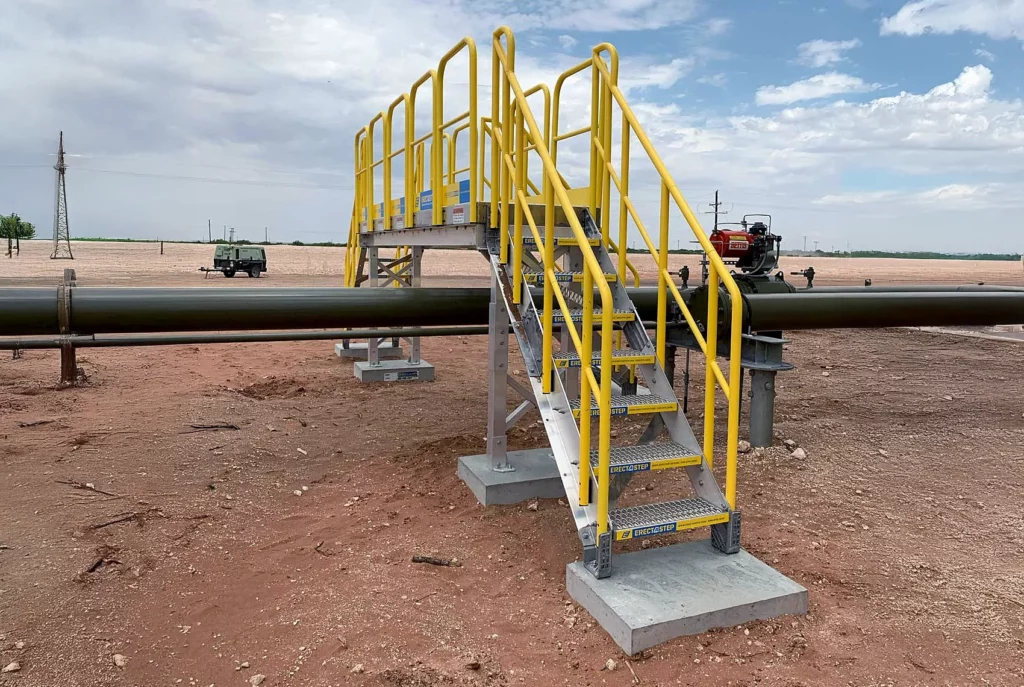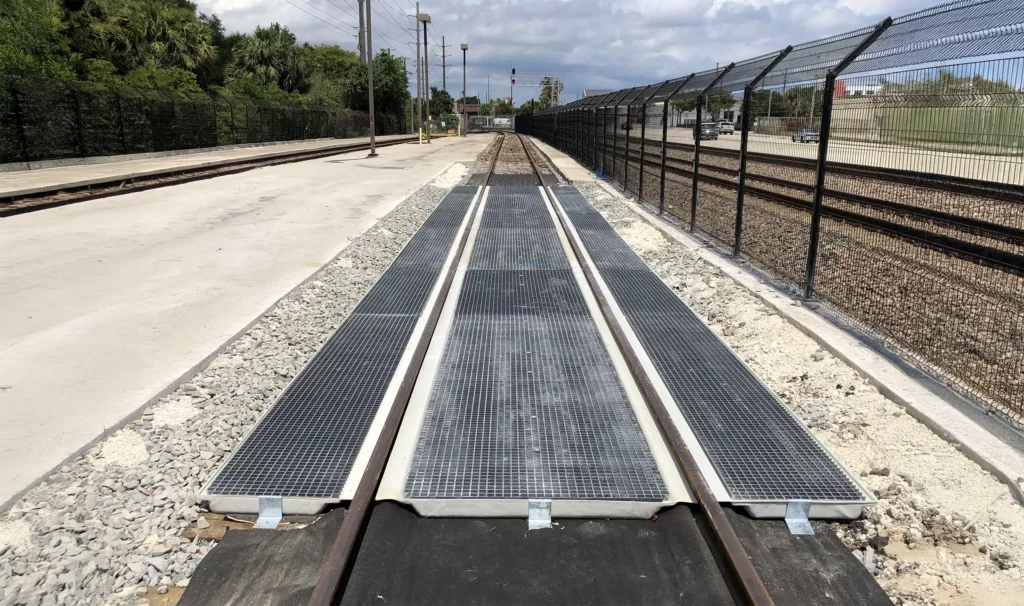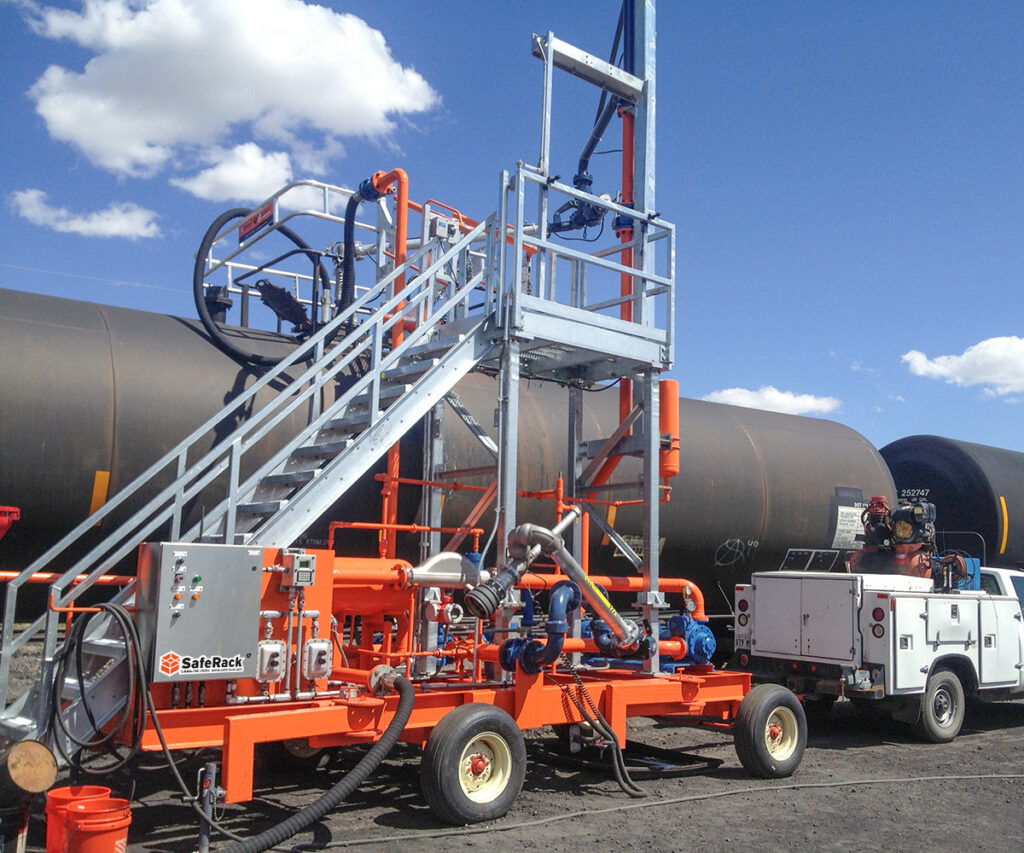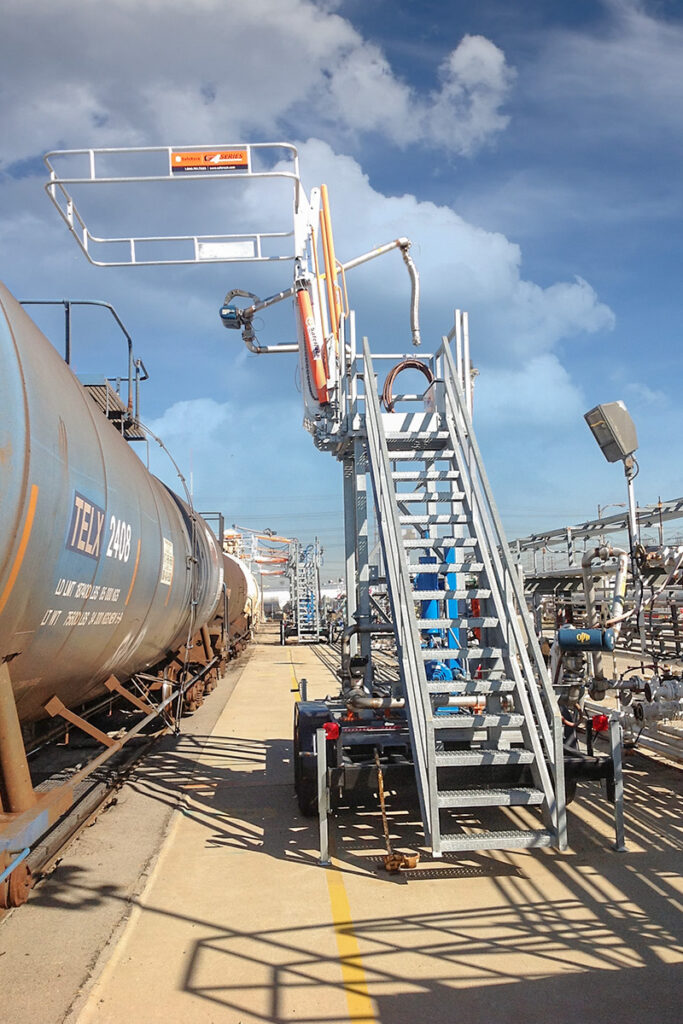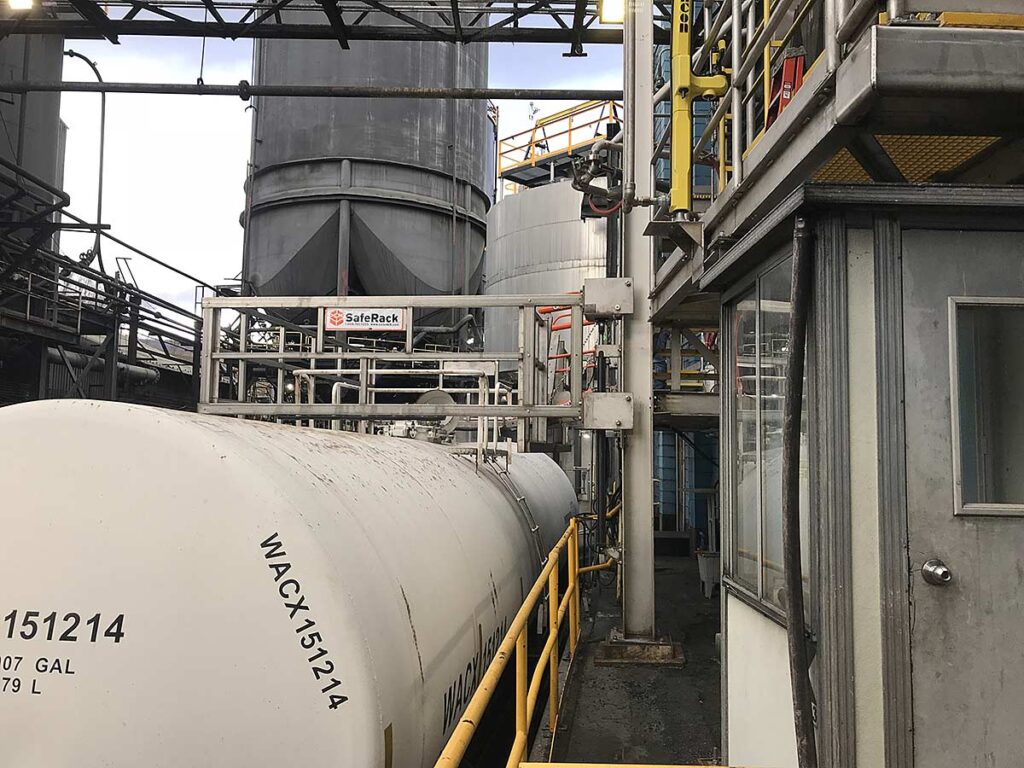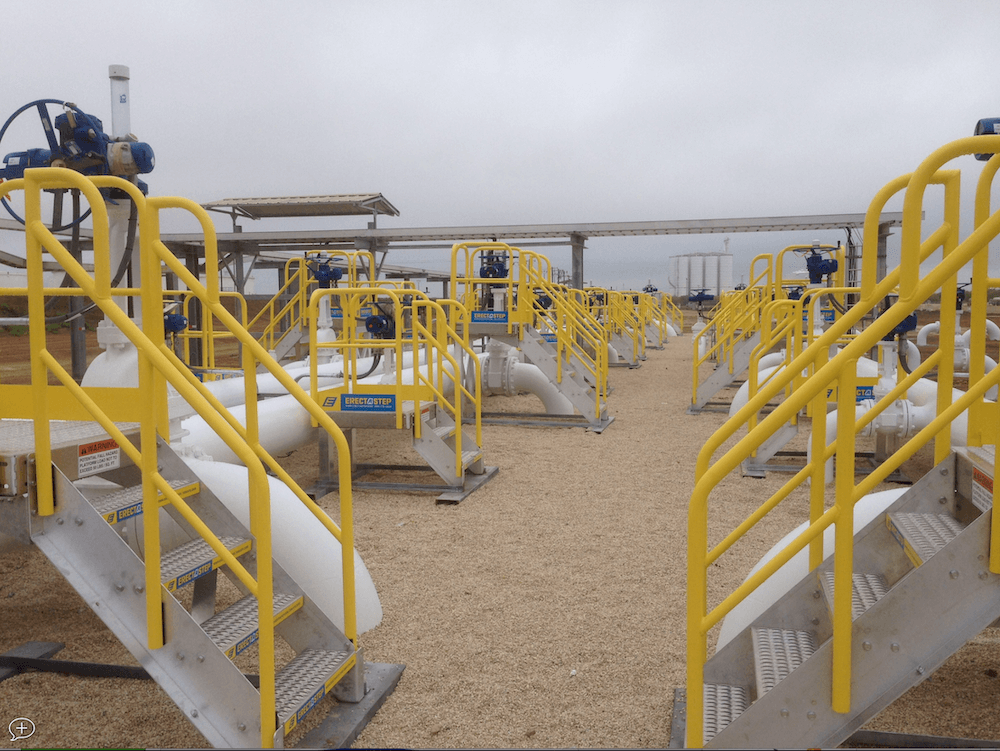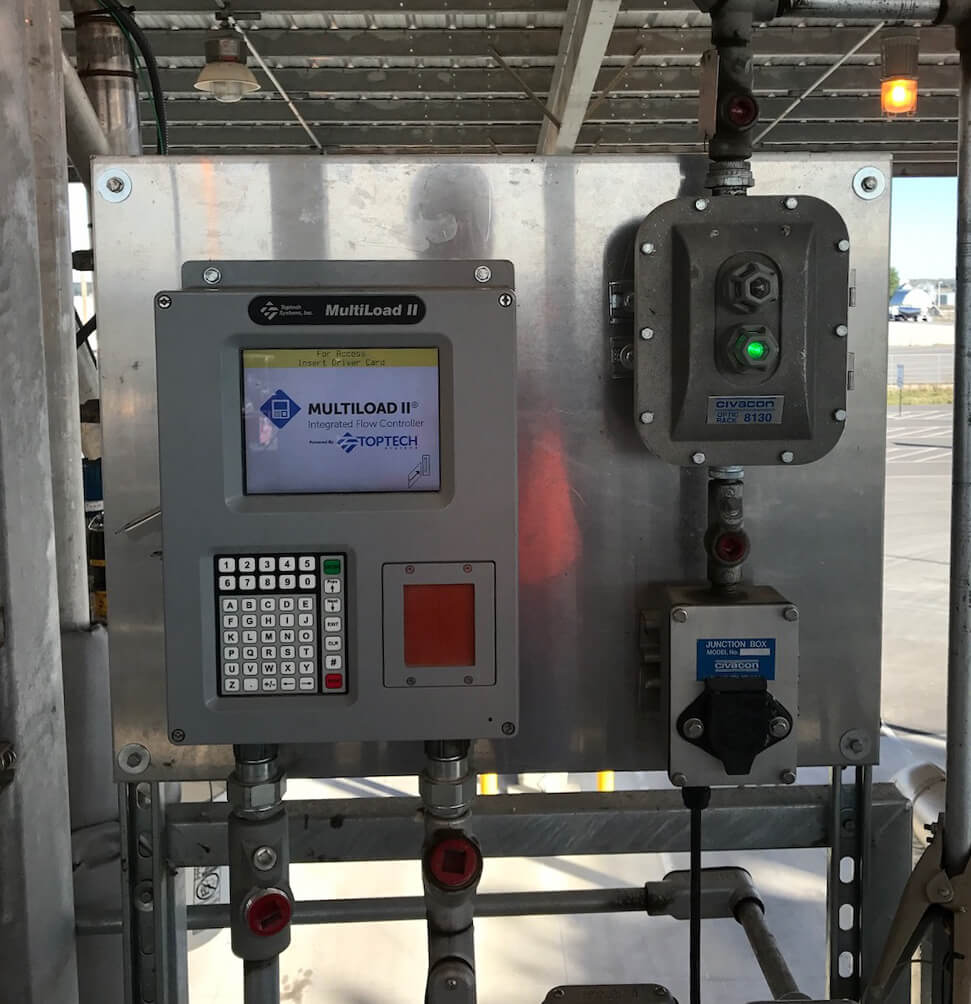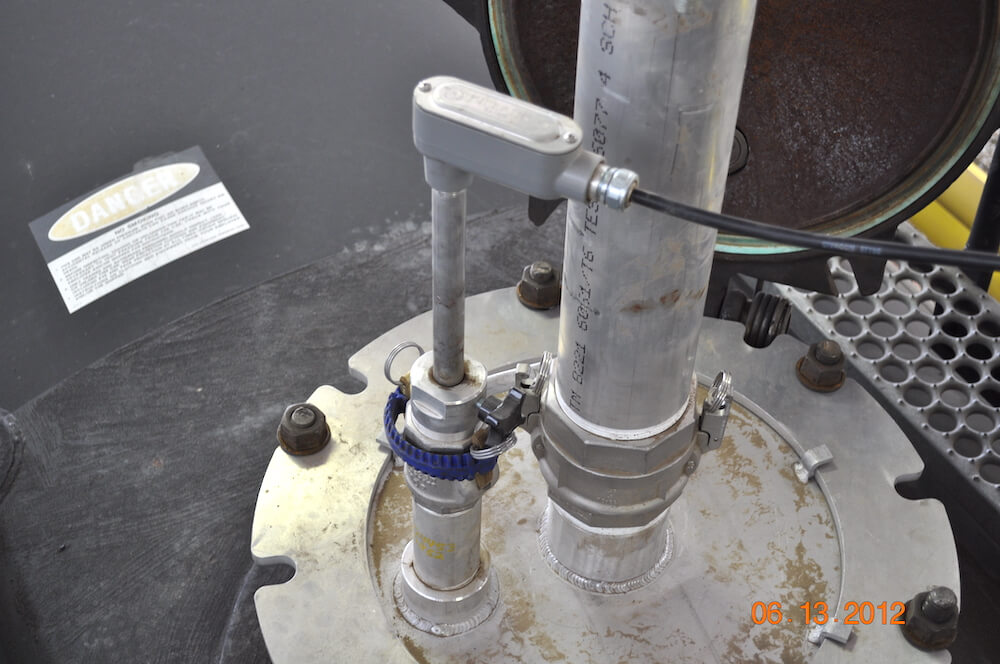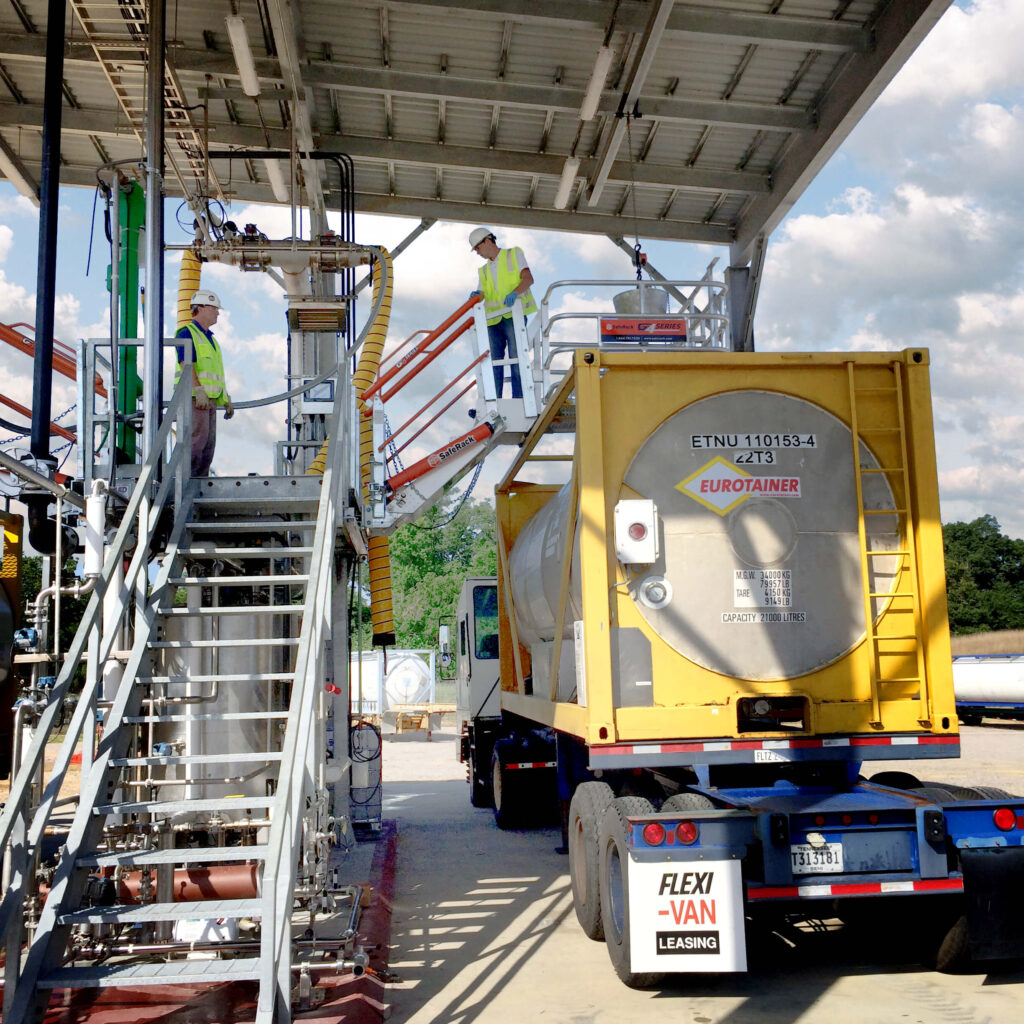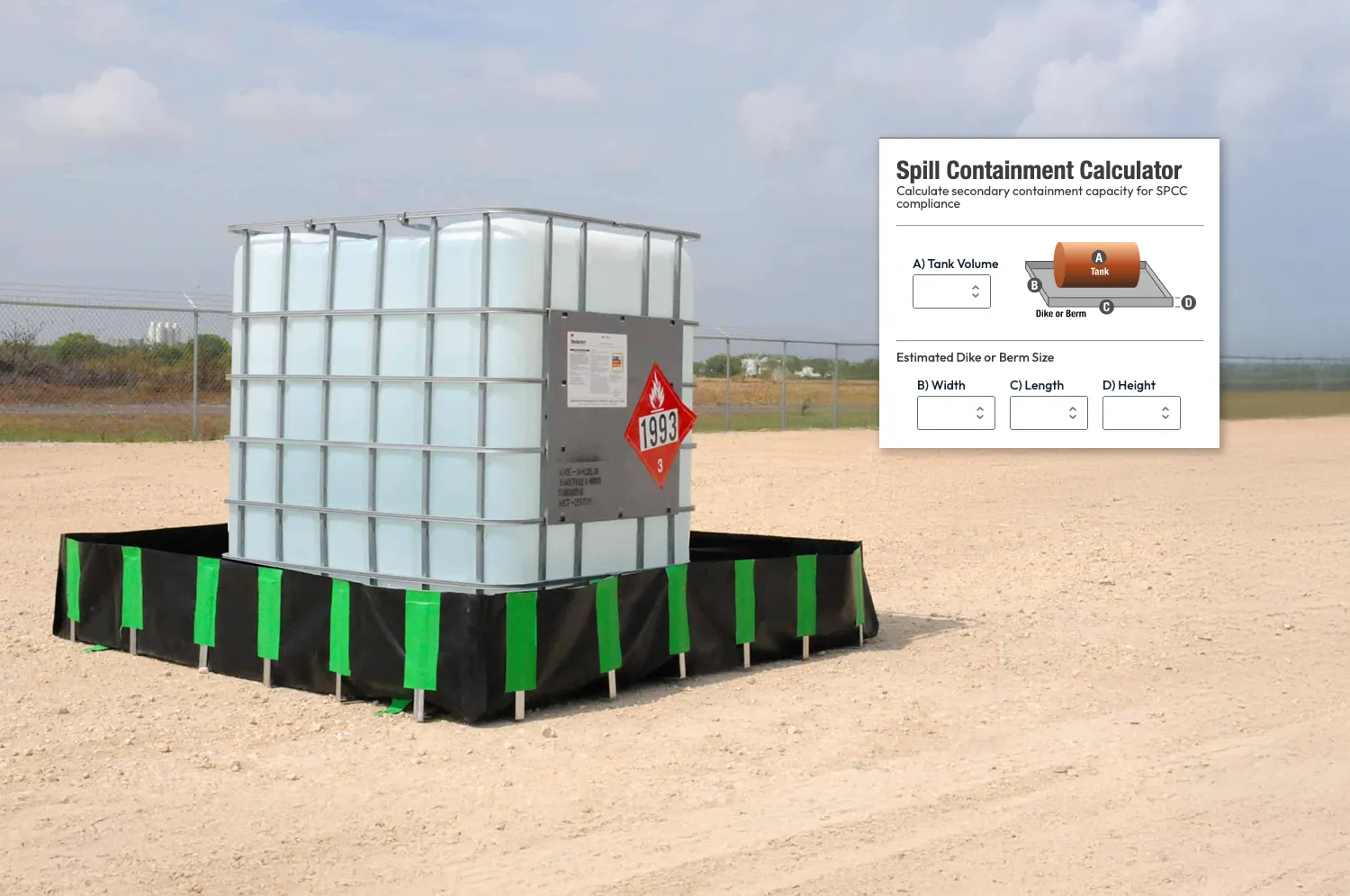Sulfur Dioxide (SO2) Handling
Operator and Environmental Safety – SafeRack has been providing safe, reliable platforms, handrails, and gangway solutions to the chemical industry for many years. From multifaceted fall prevention retrofits to new builds, SafeRack’s priorities are operator and environmental safety while still focusing on creating an efficient and productive solution that allows a significant return on investment.
Sulfur Dioxide
Sulfur Dioxide Chemical Overview
Do not breathe gas or vapors. Use only in well ventilated areas with proper respiratory protection. Do not get liquid or vapor in eyes, skin or clothing. Safety showers and eyewash stations should be immediately available. Best practice loading/unloading includes wearing chemical-resistant clothing, gloves, splash goggles, and respirator at all times to protect eyes, lungs, and skin. In the event of a leak or spill, evacuate all personnel to a safe area. Remove all sources of ignition. Toxic, corrosive vapor can spread from spill. Sulfur dioxide is a corrosive gas; the vapors are heavier than air and may accumulate in confined spaces, particularly at or below grade. In the event of a spill or leak, exit the area immediately. Eliminate heat and ignition sources such as sparks, open flames, hot surfaces and static discharge. Post “No Smoking” signs.
What is Sulfur Dioxide?
sulfur dioxide is the chemical compound with the formula SO2. It is a toxic gas responsible for the smell of burnt matches. It is released naturally by volcanic activity and is produced as a by-product of copper extraction and the burning of fossil fuels contaminated with sulfur compounds. Sulfur dioxide has a pungent smell like nitric acid. Sulfur dioxide is also referred to as Sulfurous anhydride, sulfurous oxide, or refrigerant gas. In the United States, Sulfur Dioxide is a “tight-fill” (closed-loop) loading operation and is loaded into rail cars via 3” chemical hoses or 316 stainless steel loading arms.
Sulfur Dioxide, if not handled properly can cause serious injuries and Personal Protective Equipment (PPE) is required. Additionally, because operators are on top of the vehicles during the loading process, fall prevention is essential, not only for safety but increases throughput. Although no two Sulfur Dioxide Loading solutions will be identical, the product itself determines much of the critical design criteria that will ensure that optimum safety and productivity can work together in harmony.
Sulfur Dioxide is typically shipped in DOT-106A non-insulated tank cars with safety valves that meet the DOT specification for the transportation of Sulfur Dioxide and other like commodities.
Trailers are top unloaded. An extension pipe with two valves is flanged to the top of the trailer. One valve is located at the top, and the other is at the end of the pipe on the bottom for easy access. Trailers should arrive on-site with blind flanges.
All trailers must be equipped with pressure relief valves; and trailers with bottom outlets must. Tank truck (un)loading procedures are similar to railcar applications with the trailers meeting established DOT requirements for hauling sulfur dioxide or similar commodities. Approved DOT trailers include MC 300 thru MC 312 , MC 330 and MC 331 be equipped with remote controlled stop valves.
Sulfur Dioxide is regulated by the U.S. Department of Transportation (DOT) and is classified as a corrosive and flammable gas with the DOT identification number UN 1079.
Only properly trained and equipped personnel should be permitted to unload tank trucks or handle cylinders. Operators should wear an approved respiratory protective device, and impervious clothing, footwear, gloves, and goggles.
OSHA Permissible Exposure Limits (PEL) @ 2 ppm in an 8 hour day. At concentrations above 50 ppm are considered dangerous, and above 100ppm are considered life-threatening. Exposure to high concentrations may result in pulmonary edema and paralysis.
Sulfur dioxide is not compatible with carbon steel or 304 stainless steel so great care should be taken to avoid contact with these materials. However, aluminum, galvanized and 326 stainless steel have minimal effects (minor corrosion or discoloration) when exposed to Sulfur dioxide.
Sulfur Dioxide Products
Semi Trailer & Truck Steps
Semi-truck steps for loading semi and flatbed trailers
Crude oil sample catchers and oil thieves
We offer Tulsa Oil Thieves in three models and five sizes. All of the sample catchers feature single trip (original with the Tulsa Thief), antifouling flat-ball assembly, a full opening horizontal closure system with rotating valve, two adjustable springs (one for closing tension and one for tripping tension for more flexible adjustment) and adjustable graduated trip rods that hold the thief in an upright position as a hydrometer cylinder.
Barrier Gates
YellowGates XL barrier gate provides 6 feet of adjustability protects every pathway in your facility
Railcar Movers & Brake Sticks
SafeRack’s railcar wheel chocks provide fast blocking of all types of railcars
Safety Swing Gates
YellowGate – The Original Universal Self Closing Safety Gate
Loading Dock Stairs
Prefabricated IBC, ADA, or OSHA Aluminum Loading Dock Steps that bolt together in about an hour.
Mobile Work Platforms
The MP Series is a highly mobile work platform designed to bring the workspace and stability of a fixed platform to a rolling stair mobile unit.
Signs and Signals
Signs and Signals
Railcar Chocks/Blocks
SafeRack’s railcar wheel chocks provide fast blocking of all types of railcars
Lighting
Industrial Lighting Solutions for Hazardous Environments
Drench Showers
Emergency Drench Showers and Safety Eyewash Stations
Pipe Racks
Prefabricated Pipe Racks Constructed Faster and Easier Than Ever Before
Tools and Loading Accessories
A comprehensive range of facility and loading terminal equipment, accessories and safety solutions.
Metering
Pressure Gauges, Meters, Sight-flow indicators
Overfill Protection
Preventing costly spills and ensuring safety during tank loading operations
Grounding/Earthing
Protect personnel, product, and terminals with static grounding (earthing)
Grounding & Monitoring
Protect personnel, product, and terminals with static grounding (earthing) solutions
Beam Trolley & Lifeline
Fall Arrest Systems for Horizontal Mobility at Heights
Safety Gates
Industrial safety swing gates, facility guardrails, mezzanine gates and barriers gates.
Drum & IBC Spill Containment
Interior and exterior SPCC compliant and EPA approved spill pallets
Truck Spill Containment
SPCC & EPA Compliant Truck Spill Containment Solutions
Railcar Track Pans
SPCC & EPA Compliant Track pans for capturing hazardous spills from railroad tankers and railcars
Spill Containment
Spill Containment
Top Loading Arms
Top Loading Arms
Loading Arms & Couplings
Loading Arms & Couplings
Safety Cages
Fall prevention enclosures for accessing trucks or railcars.
Portable Access Platforms
SafeRack’s MAUI mobile access units provide secure, adjustable stair solutions for safely accessing elevated truck and railcar work areas, even in the most challenging environments.
Transloaders & Metering Skids
Metering skids configured for a variety of materials, including propane, ethanol, crude oil, aviation fuel, NGL, LPG, and other refined petroleum products.
MaxRack Elevated Platforms
Powered elevating platform system for accessing railcars and trucks
Ship & Fixed Ladders
Fixed ladder and steep inclined ship ladders for areas where standard stair length runs are not feasible.
Crossover Stairs
Crossover Stairs
Industrial Metal Stairs
Prefabricated industrial metal stairs and access platforms offer safe, durable, and expandable access with quick, no-fabrication installation.
Truck & Railcar Gangways
The industry’s safest and most ergonomic gangway for truck and railcar access.
Gangways
Truck, Railcar and Marine Gangways, Safety Cages, and Inspection Services
Stairs & Work Platforms
Fixed and Mobile Access Stairs, Work Platforms, Crossover Stairs, Rolling Stairs & Mobile Platforms, Roof Stairs and Access, Ship Ladder
Sulfur Dioxide
Solutions
Below are some of the loading and unloading solutions for illustrative purposes only. Our experts will work with you and your team for a custom solution to suit your needs.
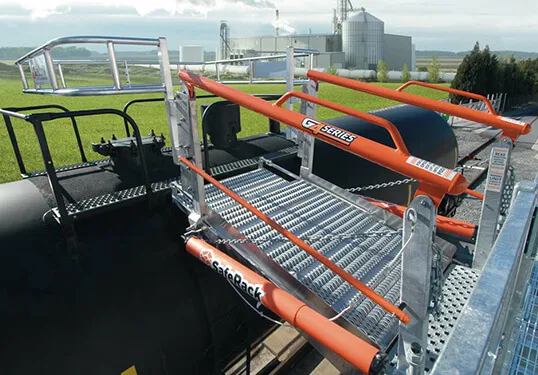
Loading Gangways & Safety Cages
Wide access gangways (48″-60″) are preferable to allow safe access and egress to and from the vessel. In addition, a wider gangway reduces the risk of PPE getting caught, torn or damaged, while improving productivity and safety. Powered gangway solutions allow for hydraulic and pneumatic use, reducing stress and strain on operators.
Each gangway is fitted with a two-rail safety cage for the railcar crash box or a four-rail safety cage for access trucks.
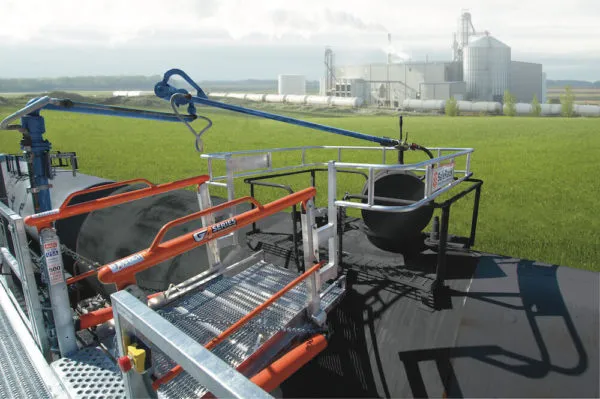
Loading Arms
Chemicals are typically loaded into railcars or tank trucks via boom-supported 316 stainless steel loading arms or chemical hoses with a flange connection. The arm or hose uses a top inlet with a control valve to ensure that it is self-draining after use and is supported along the length of a mechanical loading arm (by-pass arm) to improve handling. When required, a vapor hose can be mounted on one by-pass arm.
When unloading, use of a rigid 316 stainless steel arm with EPDM or PTFE seals or a braided stainless steel chemical hose is typical. Purge lines can be fitted to the arm for nitrogen purging. Additional features such as parking latches with proximity sensors can be incorporated into the total system to ensure the arm is correctly stowed when not in use to prevent rail movement.
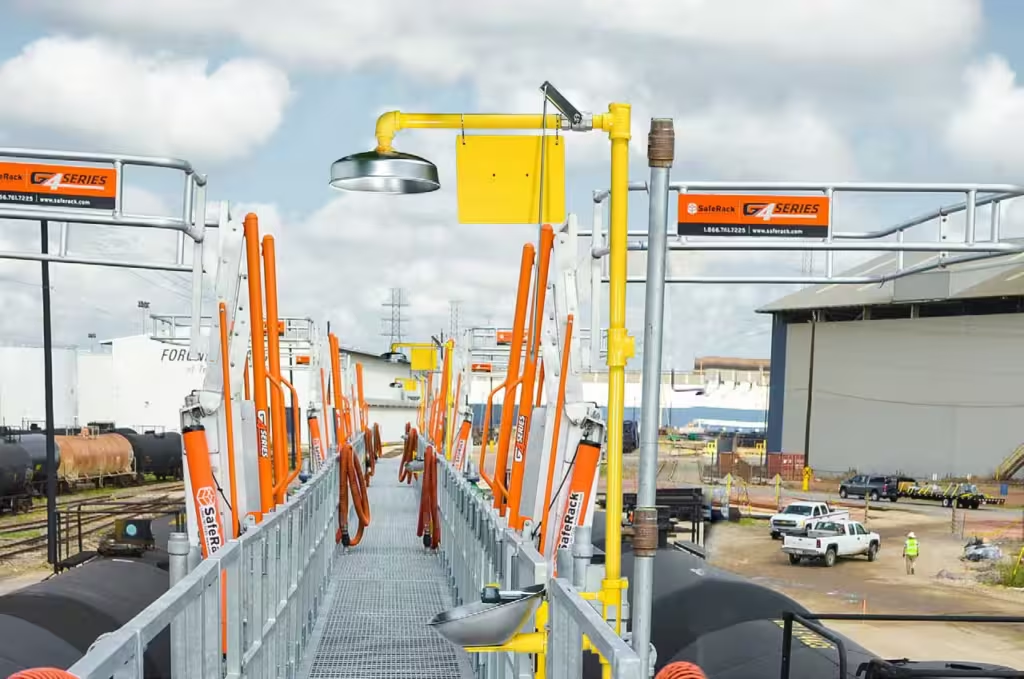
Eye Wash/Drench Showers
ANSI guidelines state that an Eye Wash/Drench Showers need to be located 10 seconds or 55’ (16.8m) from contaminants or hazardous materials.
Eyewash stations need to be on the same horizontal plane with no obstructions.
Therefore, we propose installing a standard combination Drench Shower/Eyewash Unit, which will save limited space and fit easily into any work environment.
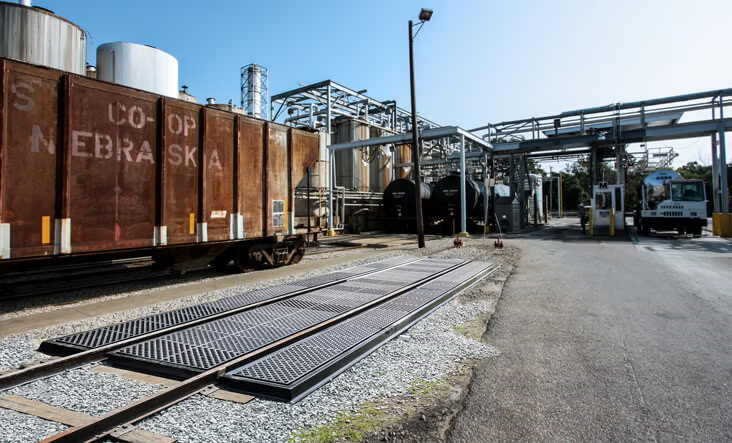
Spill Containment
Spill containment, such as railcar track pans will be provided at the point of loading operations and are an essential piece of equipment in overall site safety and environmental protection.
Wheel chocks allow for safe access to and storage of treatment chemicals, while spill containment pans utilized at the point of loading operations serve as essential safety and environmental protection tools.
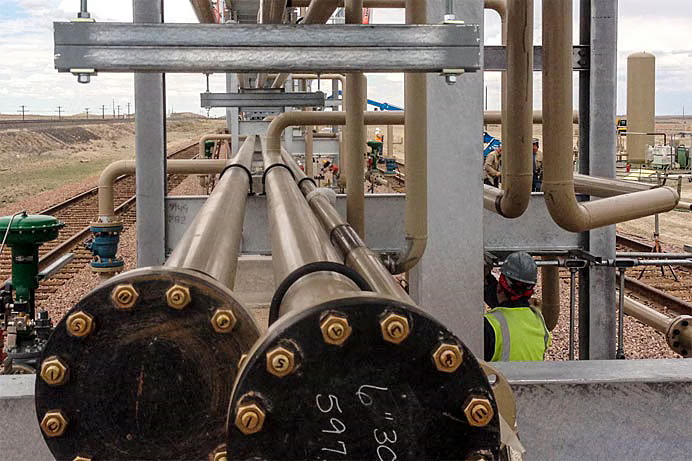
Piperacks
Because chemical plants have pipe runs throughout the facility, ErectaRack pipe racks are pre-fabricated for a variety of pipe dimensions and applications. Because they’re pre-engineered, ErectaRack skips the long engineering and fabrication process, saving weeks, if not months in the installation process.
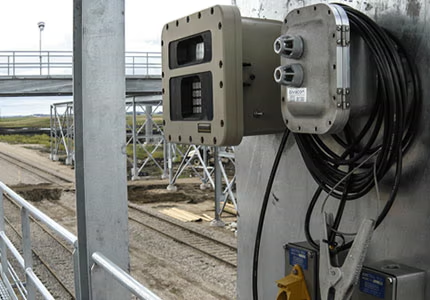
Grounding
Proper grounding is essential when loading and unloading chemicals to prevent static electricity buildup, which can cause sparks and lead to fire or explosion hazards. SafeRack offers grounding systems designed to ensure a secure connection between the transport vehicle and the facility, meeting industry safety standards while protecting personnel and equipment.
Vehicle grounding and bonding — ensure true grounding before product flow is permitted
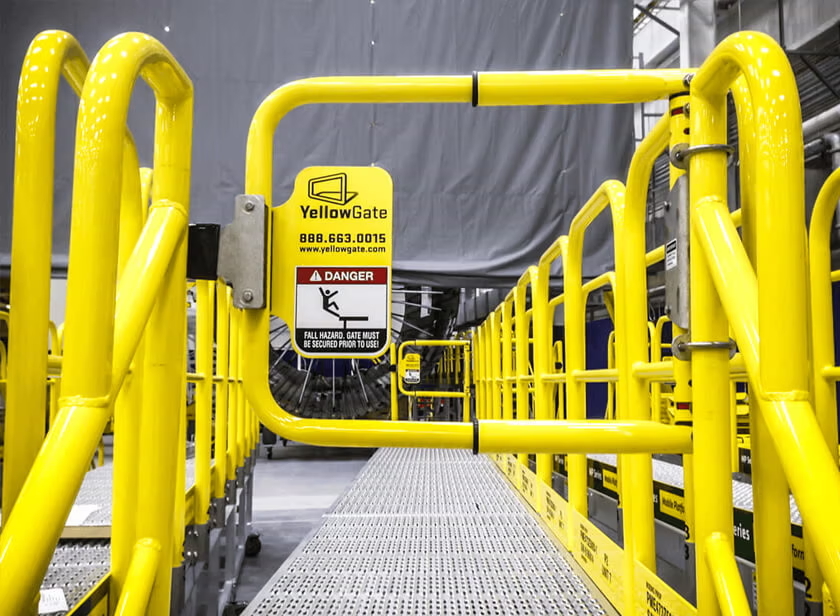
Safety Gates, Stairs, Ladders, & Platforms
Safety Gates will be installed at the top of stairs and any other openings to ensure operator safety.
SafeRack’s line of industrial safety gates is the most flexible product on the market with the ability to span openings between 16” and 36” and is field adjustable with nothing more than a wrench. We also have guardrails, metal handrails, and full-fledged fall protection solutions with customizable options to fit your needs.
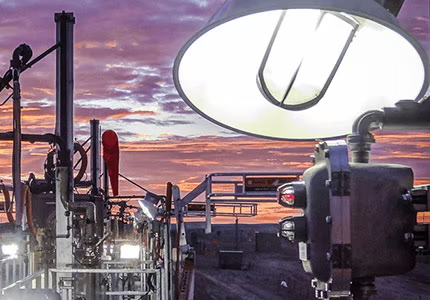
Loading Platform Options
Lighting – General exterior and task lighting to illuminate work and walk areas.
Platform & Canopies – Full platform canopies reduce exposure to the elements and improve the safe and productive loading operation from the operator’s perspective.
Operator Shelter—Depending on your site requirements, consider the requirement of an operator or guard building to keep personnel out of the elements. This can be customized to meet specific site requirements.
Wheel Chocks – SPCC options to allow for safe access and storage of water treatment chemicals.
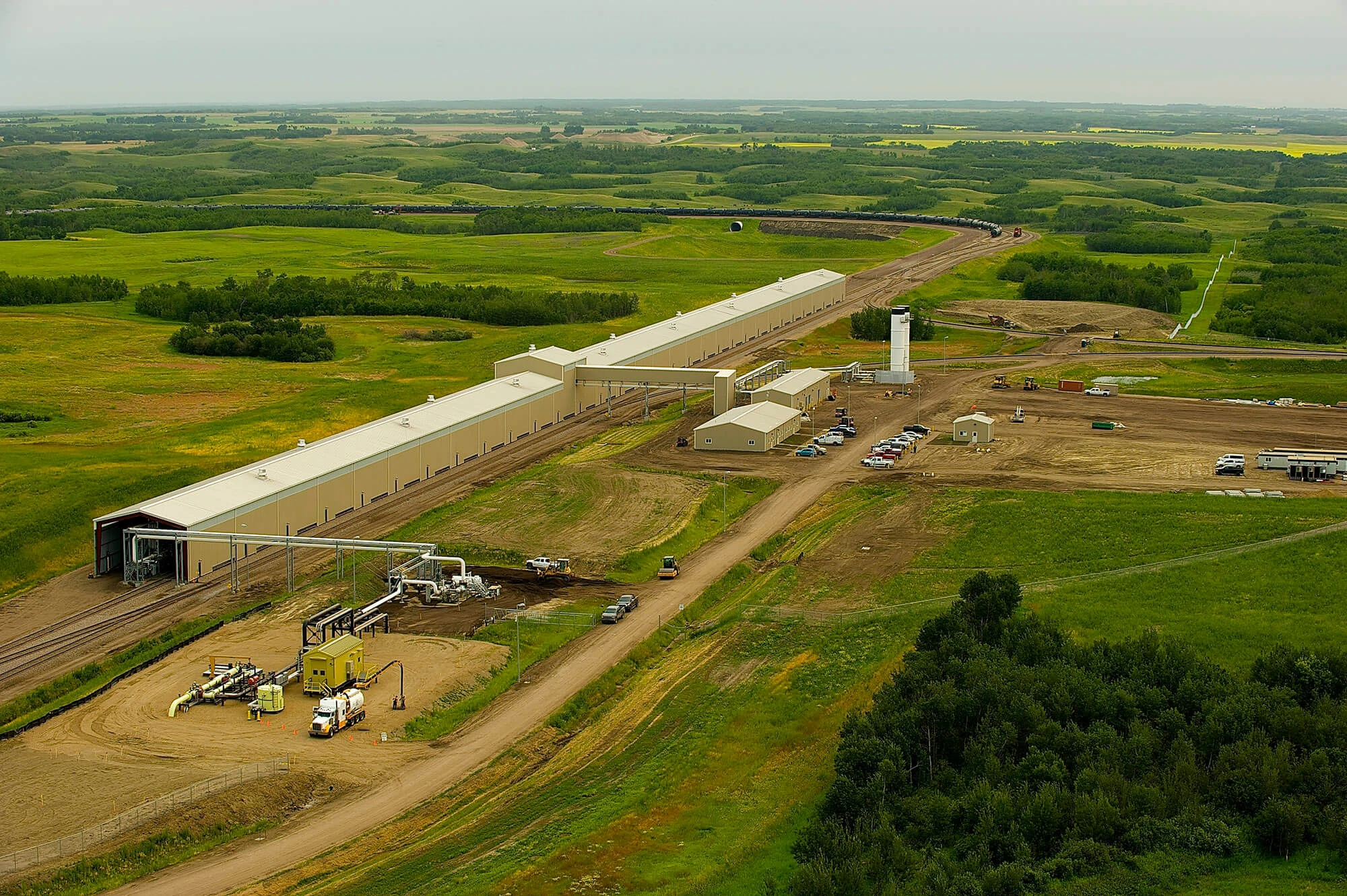
North America’s largest loading terminal
As one of the primary railcar loading points, Hardisty is one of the major crude oil hubs in North America and a major origination point of pipelines that export to the United States. SCS was asked to supply and construct a SafeRack crude oil loadout terminal spanning nearly half a mile. The USD Hardisty terminal can load up to two 120-railcar unit trains per day and consists of a fixed loading rack with 62 railcar loading positions enclosed, separate control, operator, and mechanical buildings, as well as a unit train staging area and loop tracks capable of holding multiple unit trains simultaneously. SCS also supplied and installed boom-supported loading arms with supply and vapor management systems.
Why SafeRack?
The SafeRack approach is collaborative. Let’s call it The SafeRack Way. Over many years, we have amassed a great deal of experience and understanding of the safety aspects involved in loading road tankers and railcars, as well as the behavioral habits of the operators.
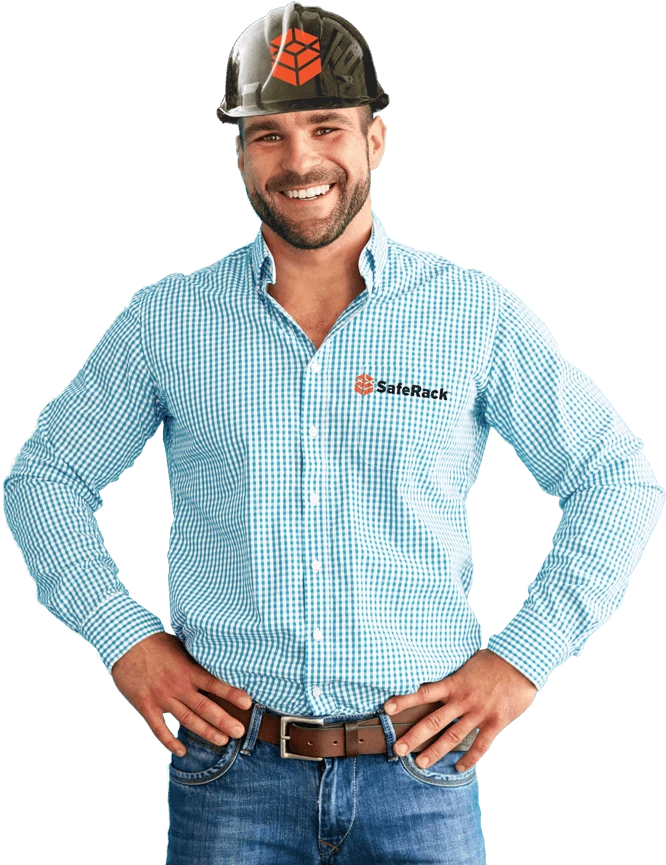
Sulfur Dioxide
Is your facility compliant with ANSI, OSHA, and local safety codes? We can help!

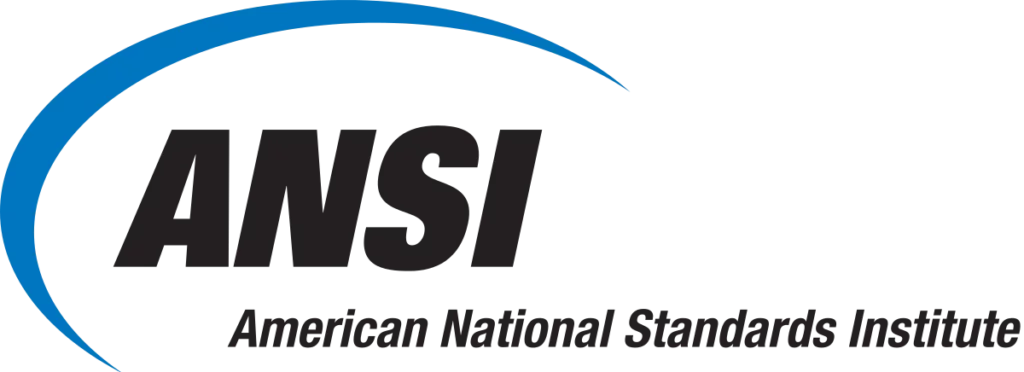
EMERGENCY EYEWASHES / SHOWER EQUIPMENT AND THE ANSI/ISEA Z358.1 – 2014 STANDARD
Following eye contact, you must start washing with water immediately to prevent permanent damage. In the event of skin contact, you must start washing with water immediately to prevent slow-healing chemical burns.
Are you aware that ANSI guidelines state that Eye Wash/Drench Showers need to be located 10 seconds or 55′ from contaminates or hazardous materials and located on the same horizontal plane, with no obstructions? If bottom loading/unloading, an additional shower should be located at grade as well. SafeRack provides the above equipment plus much more needed to keep employees safe and expedite bulk chemical loading and unloading.
OSHA Regulation Experts – Does your existing chemical safety equipment or chemical loading systems meet OSHA’s latest requirements? SafeRack’s professional technical sales consultants are available to meet with your team to make recommendations to keep your facility in front of OSHA’s ever-changing country and region-specific standards and regulations, including lifeline and trolley beam fall arrest systems, metal stairs, and access platforms.

Petrochemicals are made from either petroleum or natural gas feedstock. A wide variety of petrochemicals are created/produced depending on the process.
Synthesis gas (SynGas) – A mixture comprising of carbon monoxide, carbon dioxide, and hydrogen. Common Synthesis Gas is Ammonia and Methanol. Often used for creating Fertilizers and explosives. Synthesis gas is a mixture of carbon monoxide and hydrogen used to make ammonia and methanol. Ammonia is used to make the fertilizer urea, and methanol is used as a solvent and chemical intermediate. Steam crackers are not to be confused with steam reforming plants used to produce hydrogen and ammonia.
Aromatics – Aromatics are hydrocarbons that consist exclusively of the elements carbon and hydrogen. Common Aromatics are Benzene, Toluene, and Xylenes. Often used for creating Dyes, synthetic detergents, fibers, and plastics.The catalytic reforming of naphtha produces aromatics, which include benzene, toluene, and xylene. Together they are referred to as BTX and are predominantly obtained from petroleum refineries by the extraction from the reformate produced in catalytic reformers using naphtha obtained from petroleum refineries.
Olefins – The most reactive class of hydrocarbons tend to crack. Common Olefins are Ethylene, Propylene, and Butadiene. Often used for creating plastics, and synthetic rubber. Chemical plants produce olefins by steam cracking of natural gas liquids like ethane and propane. Olefins include ethene, propene, and butadiene. Ethylene and propylene are chief sources of both plastic products and industrial chemicals. Butadiene is mainly used in the production of synthetic rubber.



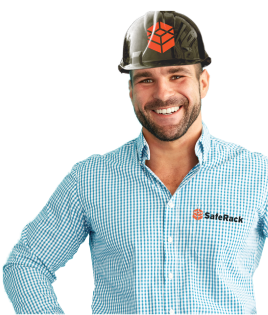

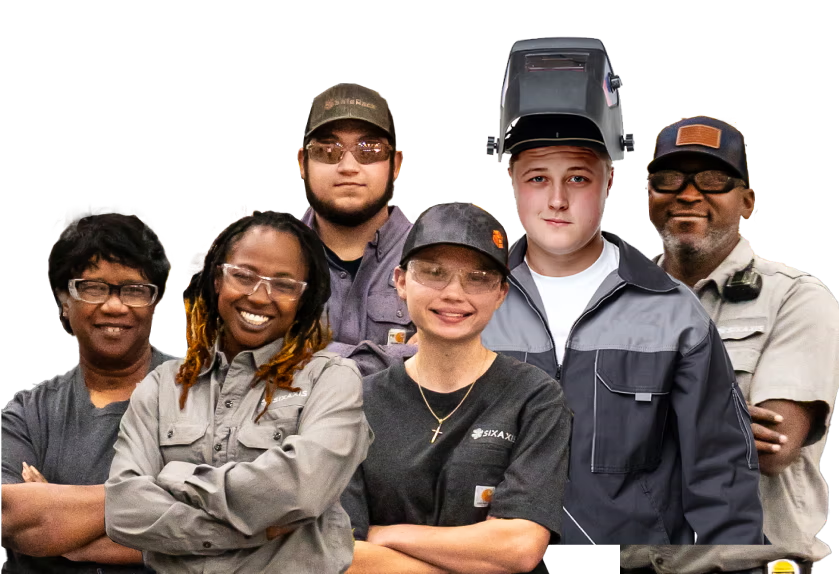




 Download
Download

